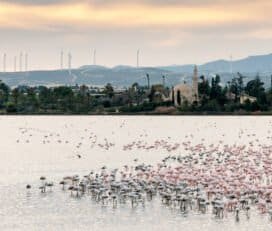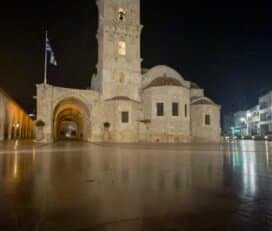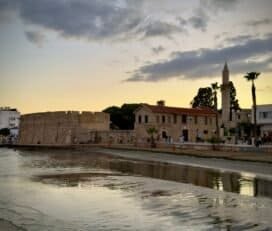Archaeological Site of Amathous – Limassol, Cyprus
Overview
The Archaeological Site of Amathous is one of the most significant ancient city-kingdoms of Cyprus, offering visitors a fascinating glimpse into more than three millennia of island history. Located on the eastern edge of Limassol, overlooking the Mediterranean Sea, Amathous was once a powerful coastal settlement known for its temples, royal palaces, and bustling port. Founded around 1100 BC and inhabited until the early Byzantine period, it played a vital role in the island’s political, economic, and religious life. Today, visitors can explore the ruins of temples, baths, an agora, and the remains of the acropolis, all set against sweeping sea views that make Amathous one of Cyprus’s most atmospheric archaeological sites.
Why Visit
- Explore one of the oldest and most important ancient city-kingdoms in Cyprus
- Walk among ruins dating from the Iron Age to the Byzantine era
- See the remains of the Temple of Aphrodite and Adonis, once a major religious center
- Enjoy panoramic views of the Mediterranean coastline from the acropolis
- Discover centuries of history in a serene, uncrowded setting near Limassol
Highlights
- Temple of Aphrodite: The centerpiece of Amathous, dedicated to the island’s most famous goddess of love and beauty
- Acropolis: The upper city, offering exceptional views and containing the remains of sanctuaries and ancient walls
- Agora: The main marketplace of ancient Amathous, featuring columns and foundations from the Hellenistic and Roman periods
- Royal Tombs and Baths: Excavated areas showcasing the city’s ancient lifestyle and funerary customs
- Massive Stone Vessels: Two gigantic limestone basins used for religious rituals, now displayed both on-site and at the Louvre Museum
History & Cultural Significance
The city of Amathous was founded around 1100 BC, likely by settlers from the Aegean and indigenous Cypriots. It soon became one of the island’s most prosperous city-kingdoms, renowned for its port and its devotion to Aphrodite-Amathousia, a local version of the goddess of love. Ancient texts describe Amathous as a center of worship and pilgrimage, second only to Paphos. Throughout the centuries, the city flourished under Phoenician, Greek, and later Roman influence. During the Byzantine era, it became a Christian bishopric before gradually declining and being abandoned by the 7th century AD following Arab raids. Excavations that began in the 19th century have revealed temples, homes, and artifacts that testify to Amathous’s rich cultural heritage. In 1980, the site was designated as an Ancient Monument under the protection of the Cyprus Department of Antiquities.
Typical Costs & Tickets
Entrance to the Archaeological Site of Amathous costs approximately €2.50 per person, making it one of the best-value historical attractions in Cyprus. Children under 12 usually enter free. Tickets can be purchased at the small visitor kiosk at the entrance. The site is open year-round, with typical hours from 8:00 AM to 5:00 PM in winter and 8:00 AM to 7:30 PM in summer. There are shaded benches and informational plaques throughout, though the terrain can be uneven—comfortable shoes are recommended. Guided tours can be arranged through local agencies in Limassol or by contacting the Cyprus Department of Antiquities in advance.
Best Time to Visit
The best time to visit Amathous is during spring (March–May) or autumn (September–November), when temperatures are mild and the hillsides bloom with wildflowers. Early morning and late afternoon visits offer the best light for photography, as the ruins and sea take on golden hues. Summer visits can be hot, but the coastal breeze provides some relief. Because the site is less crowded than other archaeological attractions like Kourion, visitors can often explore in near solitude, especially during weekdays.
Nearby Experiences
The Archaeological Site of Amathous is conveniently located just 10 kilometers east of Limassol city center. Nearby, visitors can explore the Ancient Kourion ruins to the west, which feature a Roman amphitheater and mosaics. The coastal Amathus Beach area offers a relaxing stop after sightseeing, with cafés and beach bars nearby. For those interested in local history, the Limassol Archaeological Museum houses many artifacts excavated from Amathous, including pottery, statues, and jewelry. The modern St. Raphael Marina and the Limassol Promenade are also close by, ideal for dining or an evening stroll.
Travel Tips
- Wear sturdy shoes — the terrain is uneven and includes gentle slopes
- Bring water, sunscreen, and a hat, as shade is limited on the site
- Allow at least one hour to explore both the lower town and upper acropolis areas
- Visit early or late in the day for the best light and cooler temperatures
- Combine your visit with nearby Limassol attractions for a half-day cultural trip
Fun Facts & Local Legends
- The cult of Aphrodite-Amathousia at Amathous was said to predate even the famous sanctuary in Paphos
- The site’s massive stone vessels each weigh over 13 tons — one remains in situ, the other is housed in the Louvre Museum in Paris
- Amathous minted its own coins, featuring the image of Aphrodite and the city’s emblematic lion
- Local legend claims that King Cinyras, the father of Adonis, once ruled from Amathous
















